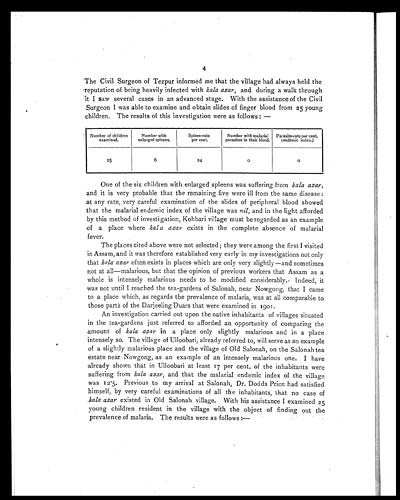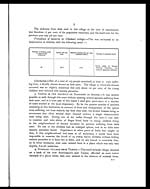Medicine - Institutions > Army health reports and medical documents > Scientific memoirs by officers of the Medical and Sanitary Departments of the Government of India > Number 19 - On kala azar, malaria and malarial cachexia > On kala azar, malaria and malarial cachexia
(12) Page 4
Download files
Individual page:
Thumbnail gallery: Grid view | List view

4
The Civil Surgeon of Tezpur informed me that the village had always held the
reputation of being heavily infected with kala azar, and during a walk through
it I saw several cases in an advanced stage. With the assistance of the Civil
Surgeon I was able to examine and obtain slides of finger blood from 25 young
children. The results of this investigation were as follows :—
| Number of children examined. |
Number with enlarged spleens. |
Spleen-rate per cent. |
Number with malarial parasites in their blood. |
Parasite-rate per cent. (endemic index.) |
| 25 | 6 | 24 | 0 | 0 |
One of the six children with enlarged spleens was suffering from kala azar,
and it is very probable that the remaining five were ill from the same disease :
at any rate, very careful examination of the slides of peripheral blood showed
that the malarial endemic index of the village was nil, and in the light afforded
by this method of investigation, Kohbari village must be regarded as an example
of a place where kala azar exists in the complete absence of malarial
fever.
The places cited above were not selected; they were among the first I visited
in Assam, and it was therefore established very early in my investigations not only
that kala azar often exists in places which are only very slightly—and sometimes
not at all—malarious, but that the opinion of previous workers that Assam as a
whole is intensely malarious needs to be modified considerably. Indeed, it
was not until I reached the tea-gardens of Salonah, near Nowgong, that I came
to a place which, as regards the prevalence of malaria, was at all comparable to
those part of the Darjeeling Duars that were examined in 1901.
An investigation carried out upon the native inhabitants of villages situated
in the tea-gardens just referred to afforded an opportunity of comparing the
amount of kala azar in a place only slightly malarious and in a place
intensely so. The village of Ulloobari, already referred to, will serve as an example
of a slightly malarious place and the village of Old Salonah, on the Salonah tea
estate near Nowgong, as an example of an intensely malarious one. I have
already shown that in Ulloobari at least 17 per cent. of the inhabitants were
suffering from kala azar, and that the malarial endemic index of the village
was 12.5. Previous to my arrival at Salonah, Dr, Dodds Price had satisfied
himself, by very careful examinations of all the inhabitants, that no case of
kala azar existed in Old Salonah village. With his assistance I examined 25
young children resident in the village with the object of finding out the
prevalence of malaria. The results were as follows :—
Set display mode to: Large image | Zoom image | Transcription
Images and transcriptions on this page, including medium image downloads, may be used under the Creative Commons Attribution 4.0 International Licence unless otherwise stated. ![]()
| Permanent URL | https://digital.nls.uk/75027509 |
|---|
| Shelfmark | IP/QB.10 |
|---|---|
| Additional NLS resources: | |




